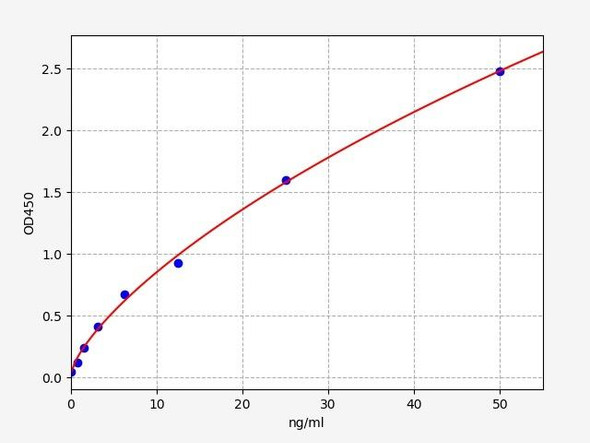Anti-PEX19 Antibody (CAB19237)
- SKU:
- CAB19237
- Product Type:
- Antibody
- Antibody Type:
- Monoclonal Antibody
- Reactivity:
- Human
- Reactivity:
- Rat
- Host Species:
- Rabbit
- Isotype:
- IgG
- Synonyms:
- PEX19
- Synonyms:
- D1S2223E
- Synonyms:
- HK33
- Synonyms:
- PBD12A
- Synonyms:
- PMP1
- Synonyms:
- PMPI
- Synonyms:
- PXF
- Synonyms:
- PXMP1
- Synonyms:
- peroxisomal biogenesis factor 19
Description
| Product Name: | PEX19 Rabbit mAb |
| Product Code: | CAB19237 |
| Size: | 20uL, 50uL, 100uL |
| Synonyms: | PEX19, D1S2223E, HK33, PBD12A, PMP1, PMPI, PXF, PXMP1, peroxisomal biogenesis factor 19 |
| Applications: | WB |
| Reactivity: | Human, Rat |
| Host Species: | Rabbit |
| Immunogen: | Recombinant protein of human PEX19. |
| Applications: | WB |
| Recommended Dilutions: | WB 1:500 - 1:2000 |
| Reactivity: | Human, Rat |
| Immunogen: | Recombinant protein of human PEX19. |
| Purification Method: | Affinity purification |
| Storage: | Store at -20°C. Avoid freeze / thaw cycles. Buffer: PBS with 0.02% sodium azide, 50% glycerol, pH7.3. |
| Isotype: | IgG |
| Sequence: | Email for sequence |
| Gene ID: | 5824 |
| Uniprot: | P40855 |
| Cellular Location: | Cytoplasm, Cytoplasmic side, Lipid-anchor, Peroxisome membrane |
| Calculated MW: | 35, 40kDa |
| Observed MW: | Refer to figures |
| UniProt Protein Function: | PEX19: Necessary for early peroxisomal biogenesis. Acts both as a cytosolic chaperone and as an import receptor for peroxisomal membrane proteins (PMPs). Binds and stabilizes newly synthesized PMPs in the cytoplasm by interacting with their hydrophobic membrane-spanning domains, and targets them to the peroxisome membrane by binding to the integral membrane protein PEX3. Excludes CDKN2A from the nucleus and prevents its interaction with MDM2, which results in active degradation of TP53. Defects in PEX19 are the cause of peroxisome biogenesis disorder complementation group 14 (PBD-CG14); also known as PBD-CGJ. PBD refers to a group of peroxisomal disorders arising from a failure of protein import into the peroxisomal membrane or matrix. The PBD group is comprised of four disorders: Zellweger syndrome (ZWS), neonatal adrenoleukodystrophy (NALD), infantile Refsum disease (IRD), and classical rhizomelic chondrodysplasia punctata (RCDP). ZWS, NALD and IRD are distinct from RCDP and constitute a clinical continuum of overlapping phenotypes known as the Zellweger spectrum. The PBD group is genetically heterogeneous with at least 14 distinct genetic groups as concluded from complementation studies. Defects in PEX19 are a cause of Zellweger syndrome (ZWS). ZWS is a fatal peroxisome biogenesis disorder characterized by dysmorphic facial features, hepatomegaly, ocular abnormalities, renal cysts, hearing impairment, profound psychomotor retardation, severe hypotonia and neonatal seizures. Death occurs within the first year of life. Belongs to the peroxin-19 family. 5 isoforms of the human protein are produced by alternative splicing. |
| UniProt Protein Details: | Protein type:Membrane protein, integral; Chaperone Chromosomal Location of Human Ortholog: 1q23.2 Cellular Component: brush border membrane; cytoplasm; cytosol; integral to membrane; intracellular membrane-bound organelle; nucleoplasm; nucleus; peroxisomal membrane; peroxisome; protein complex Molecular Function:ATPase binding; protein binding; protein N-terminus binding Biological Process: peroxisome fission; peroxisome membrane biogenesis; peroxisome organization and biogenesis; protein import into peroxisome membrane; protein stabilization; protein targeting to peroxisome; transmembrane transport Disease: Peroxisome Biogenesis Disorder 12a (zellweger) |
| NCBI Summary: | This gene is necessary for early peroxisomal biogenesis. It acts both as a cytosolic chaperone and as an import receptor for peroxisomal membrane proteins (PMPs). Peroxins (PEXs) are proteins that are essential for the assembly of functional peroxisomes. The peroxisome biogenesis disorders (PBDs) are a group of genetically heterogeneous autosomal recessive, lethal diseases characterized by multiple defects in peroxisome function. These disorders have at least 14 complementation groups, with more than one phenotype being observed for some complementation groups. Although the clinical features of PBD patients vary, cells from all PBD patients exhibit a defect in the import of one or more classes of peroxisomal matrix proteins into the organelle. Defects in this gene are a cause of Zellweger syndrome (ZWS), as well as peroxisome biogenesis disorder complementation group 14 (PBD-CG14), which is also known as PBD-CGJ. Alternative splicing results in multiple transcript variants. [provided by RefSeq, Aug 2010] |
| UniProt Code: | P40855 |
| NCBI GenInfo Identifier: | 729723 |
| NCBI Gene ID: | 5824 |
| NCBI Accession: | P40855.1 |
| UniProt Secondary Accession: | P40855,Q5QNY4, Q8NI97, D3DVE7, |
| UniProt Related Accession: | P40855 |
| Molecular Weight: | Da |
| NCBI Full Name: | Peroxisomal biogenesis factor 19 |
| NCBI Synonym Full Names: | peroxisomal biogenesis factor 19 |
| NCBI Official Symbol: | PEX19 |
| NCBI Official Synonym Symbols: | PXF; HK33; PMP1; PMPI; PXMP1; PBD12A; D1S2223E |
| NCBI Protein Information: | peroxisomal biogenesis factor 19 |
| UniProt Protein Name: | Peroxisomal biogenesis factor 19 |
| UniProt Synonym Protein Names: | 33 kDa housekeeping protein; Peroxin-19; Peroxisomal farnesylated protein |
| Protein Family: | Peroxisomal biogenesis factor |
| UniProt Gene Name: | PEX19 |
| UniProt Entry Name: | PEX19_HUMAN |






